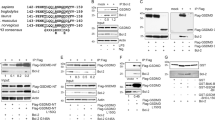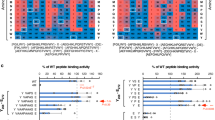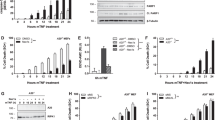Abstract
The cytoplasmic domain of the common β-chain (βc) of the granulocyte–macrophage-colony-stimulating factor (GM-CSF)/interleukin-3 (IL-3)/IL-5 receptor contains a membrane proximal region that is sufficient to mediate ligand-dependent mitogenic activity. Within this region two motifs, designated as box 1 and box 2, are highly conserved among members of the cytokine receptor superfamily. Whereas box 1 is required for the recruitment and phosphorylation of Janus kinase-2, the function of box 2 remains largely unknown. Here, we report the identification of a novel transmembrane protein (common β-chain associated protein (CBAP)) which directly associated with βc via the box 2 motif. Interestingly, such an association only occurred in the absence of GM-CSF in vivo. Ectopic overexpression of CBAP triggered apoptosis of factor-dependent cells via mitochondrial dysfunction, which could be inhibited by Bcl-2 overexpression. Reduced expression of endogenous CBAP by small interfering RNA did not interfere GM-CSF-activated signaling molecules, but such treatment significantly inhibited apoptosis induced by GM-CSF deprivation, but not other death stimuli. Domain mapping studies indicated that one apoptogenic domain of CBAP correlated with its ability to interact with βc. Taken together, these results suggest that CBAP modulates GM-CSF-deprivation-induced apoptosis possibly via a novel mechanism involving interaction with an un-liganded βc molecule.
This is a preview of subscription content, access via your institution
Access options
Subscribe to this journal
Receive 50 print issues and online access
$259.00 per year
only $5.18 per issue
Buy this article
- Purchase on Springer Link
- Instant access to full article PDF
Prices may be subject to local taxes which are calculated during checkout







Similar content being viewed by others
Accession codes
References
Argetsinger LS, Campbell GS, Yang X, Witthuhn BA, Silvennoinen O, Ihle JN et al. (1993). Identification of JAK2 as a growth hormone receptor-associated tyrosine kinase. Cell 74: 237–244.
Drachman JG, Miyakawa Y, Luthi JN, Dahlen DD, Raney A, Geddis AE et al. (2002). Studies with chimeric Mpl/JAK2 receptors indicate that both JAK2 and the membrane-proximal domain of Mpl are required for cellular proliferation. J Biol Chem 277: 23544–23553.
Gearing DP, King JA, Gough NM, Nicola NA . (1989). Expression cloning of a receptor for human granulocyte–macrophage colony-stimulating factor. EMBO J 8: 3667–3676.
Huang HM, Li JC, Hsieh YC, Yang-Yen HF, Yen JJ . (1999). Optimal proliferation of a hematopoietic progenitor cell line requires either costimulation with stem cell factor or increase of receptor expression that can be replaced by overexpression of Bcl-2. Blood 93: 2569–2577.
Kinoshita T, Yokota T, Arai K, Miyajima A . (1995). Suppression of apoptotic death in hematopoietic cells by signalling through the IL-3/GM-CSF receptors. EMBO J 14: 266–275.
Kitamura T, Sato N, Arai K, Miyajima A . (1991). Expression cloning of the human IL-3 receptor cDNA reveals a shared beta subunit for the human IL-3 and GM-CSF receptors. Cell 66: 1165–1174.
Lee SF, Huang HM, Chao JR, Lin S, Yang-Yen HF, Yen JJ . (1999). Cytokine receptor common beta chain as a potential activator of cytokine withdrawal-induced apoptosis. Mol Cell Biol 19: 7399–7409.
Miura O, Ihle JN . (1993). Subunit structure of the erythropoietin receptor analyzed by 125I-Epo cross-linking in cells expressing wild-type or mutant receptors. Blood 81: 1739–1744.
Murakami M, Narazaki M, Hibi M, Yawata H, Yasukawa K, Hamaguchi M et al. (1991). Critical cytoplasmic region of the interleukin 6 signal transducer gp130 is conserved in the cytokine receptor family. Proc Natl Acad Sci USA 88: 11349–11353.
Quelle FW, Sato N, Witthuhn BA, Inhorn RC, Eder M, Miyajima A et al. (1994). JAK2 associates with the beta c chain of the receptor for granulocyte–macrophage colony-stimulating factor, and its activation requires the membrane-proximal region. Mol Cell Biol 14: 4335–4341.
Sakamaki K, Miyajima I, Kitamura T, Miyajima A . (1992). Critical cytoplasmic domains of the common beta subunit of the human GM-CSF, IL-3 and IL-5 receptors for growth signal transduction and tyrosine phosphorylation. EMBO J 11: 3541–3549.
Sato N, Sakamaki K, Terada N, Arai K, Miyajima A . (1993). Signal transduction by the high-affinity GM-CSF receptor: two distinct cytoplasmic regions of the common beta subunit responsible for different signaling. EMBO J 12: 4181–4189.
Tanner JW, Chen W, Young RL, Longmore GD, Shaw AS . (1995). The conserved box 1 motif of cytokine receptors is required for association with JAK kinases. J Biol Chem 270: 6523–6530.
Tavernier J, Devos R, Cornelis S, Tuypens T, Van der Heyden J, Fiers W et al. (1991). A human high affinity interleukin-5 receptor (IL5R) is composed of an IL5-specific alpha chain and a beta chain shared with the receptor for GM-CSF. Cell 66: 1175–1184.
Witthuhn BA, Quelle FW, Silvennoinen O, Yi T, Tang B, Miura O et al. (1993). JAK2 associates with the erythropoietin receptor and is tyrosine phosphorylated and activated following stimulation with erythropoietin. Cell 74: 227–236.
Acknowledgements
We thank Huan-Bin Wu, Chiuan-Cheng Lin, Ya-Ting Tsai and Pei-Yi Shau for technical assistance and Dr Hsiu-Ming Shih for providing the L40 yeast strain and the LexA expressing plasmid, pBTM116. This work was supported in part by an intramural fund from Academia Sinica and by Grants NSC-95-2320-B-001-050, NSC-93-2320-B-001-041, NSC-94-2320-B-001-007 from the National Science Council of Taiwan to JJ-Y Yen.
Author information
Authors and Affiliations
Corresponding author
Additional information
Supplementary Information accompanies the paper on the Oncogene website (http://www.nature.com/onc).
Supplementary information
Rights and permissions
About this article
Cite this article
Kao, CJ., Chiang, YJ., Chen, PH. et al. CBAP interacts with the un-liganded common β-subunit of the GM-CSF/IL-3/IL-5 receptor and induces apoptosis via mitochondrial dysfunction. Oncogene 27, 1397–1403 (2008). https://doi.org/10.1038/sj.onc.1210778
Received:
Revised:
Accepted:
Published:
Issue Date:
DOI: https://doi.org/10.1038/sj.onc.1210778



